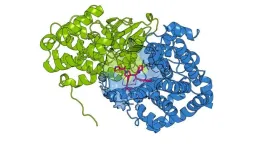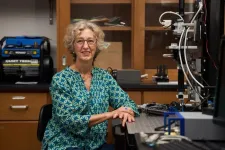(Press-News.org) LA JOLLA, CA—Some proteins in the human body are easy to block with a drug; they have an obvious spot in their structure where a drug can fit, like a key in a lock. But other proteins are more difficult to target, with no clear drug-binding sites.
To design a drug that blocks a cancer-related protein, Scripps Research scientists took a hint from the protein’s paralog, or “twin.” Using innovative chemical biology methods, the scientists pinpointed a druggable site on the paralog, and then used that knowledge to characterize drugs that bound to a similar—but more difficult to detect—spot on its twin. Ultimately, they found drugs that only bound to the protein of interest and not its highly similar sibling.
Their approach, described in Nature Chemical Biology on September 18, 2024, and dubbed “paralog hopping,” could uncover new binding sites for drugs and inform drug development more broadly, since nearly half of the proteins in human cells—including many involved in cancer and autoimmune diseases—have such paralogs.
“This method may be generally useful in cases where you have paralogs, and you are trying to find a new drug for one of them,” says senior author Benjamin Cravatt, PhD, the Norton B. Gilula Chair in Biology and Chemistry at Scripps Research. “Being able to target one paralog over another is an important goal in drug development, as two paralogs often have different functions.”
Many genes have duplicated throughout evolution, resulting in multiple copies in the human genome. In some cases, copies have evolved slightly different sequences from each other, making their corresponding proteins into paralogs. These protein paralogs remain highly similar in structure and often have redundant or overlapping functions within cells.
In recent years, Cravatt’s research team formulated an approach to develop drugs that bind to the amino acid cysteine—a protein building block with unique, highly reactive chemical properties. The scientists’ method takes advantage of cysteines as an optimal site for drugs to attach to a protein permanently, often inactivating it. However, not all proteins have accessible cysteines. In the cases of paralog pairs, one protein may have a druggable cysteine that the other does not.
“We started with this idea that if you know how to drug one protein, you can figure out how to drug its paralog in a similar way,” says Yuanjin Zhang, a graduate student at Scripps Research and first author of the new paper.
As a test case, the team tackled the paralog pair known as CCNE1 and CCNE2. Both proteins have been found to be overactive in breast, ovarian and lung cancer. However, scientists suspected that the two proteins play slightly different roles. The team posited that turning off just one protein could make treating some cancers more effective.
It has been difficult, however, to design drugs that target the CCNE1 and CCNE2 proteins to test this hypothesis. Cravatt, Zhang and their colleagues knew that CCNE2 had a druggable cysteine, while CCNE1 did not. If they could identify drugs that bound to the same spot on CCNE1, even in the absence of a cysteine, they suspected the protein would shut off.
The scientists first engineered a cysteine into CCNE1, mimicking the drug-binding spot they had pinpointed in CCNE2. They then leveraged this neo-cysteine to identify drugs that bind to CCNE1. Next, they screened a library of other chemical compounds for the ability to compete with that drug in binding to CCNE1. The team reasoned that some of the compounds that competed for the same spot would bind in ways that did not rely on the cysteine.
Indeed, Cravatt, Zhang and their colleagues discovered multiple compounds that could bind to the same site on CCNE1 even when the cysteine was removed again. Some compounds did not bind to CCNE2. Some also had opposite functions, stabilizing the molecule so that it might be more active than usual, rather than inactivating it. Structural studies revealed that the CCNE1 compounds bind to a cryptic pocket that was not previously known to be druggable.
The team says the approach highlights the importance of screening for drugs in diverse, creative ways.
“If we had just screened looking for compounds with a particular function, we would not have identified all of these various functional molecules, and if we had just looked at the structure of CCNE1, we would not have found this binding pocket at all,” says Zhang.
More research is needed to discover whether the new compounds have potential utility in treating cancer or other diseases in which CCNE1 plays a role. Next, the scientists plan to apply their paralog-hopping method to other pairs of proteins important for tumorigenesis.
In addition to Cravatt and Zhang, authors of the study, “An allosteric cyclin E-CDK2 site mapped by paralog hopping with covalent probes,” include Zhonglin Liu, Sang Joon Won, Divya Bezwada and Bruno Melillo of Scripps; and Marsha Hirschi, Oleg Brodsky, Eric Johnson, Asako Nagata, Matthew D. Petroski, Jaimeen D. Majmudar, Sherry Niessen, Todd VanArsdale, Adam M. Gilbert, Matthew M. Hayward, Al E. Stewart and Andrew R. Nager of Pfizer, Inc.
This work was supported by funding from the National Cancer Institute (R35 CA231991) and Pfizer.
//
About Scripps Research
Scripps Research is an independent, nonprofit biomedical institute ranked one of the most influential in the world for its impact on innovation by Nature Index. We are advancing human health through profound discoveries that address pressing medical concerns around the globe. Our drug discovery and development division, Calibr-Skaggs, works hand-in-hand with scientists across disciplines to bring new medicines to patients as quickly and efficiently as possible, while teams at Scripps Research Translational Institute harness genomics, digital medicine and cutting-edge informatics to understand individual health and render more effective healthcare. Scripps Research also trains the next generation of leading scientists at our Skaggs Graduate School, consistently named among the top 10 US programs for chemistry and biological sciences. Learn more at www.scripps.edu.
END
Seeing double: Designing drugs that target “twin” cancer proteins
Scripps Research scientists used knowledge about a protein to characterize drugs that selectively bind to its “twin,” or paralog.
2024-10-01
ELSE PRESS RELEASES FROM THIS DATE:
Fierce names Insilico Medicine as one of its Fierce 50 Honorees of 2024
2024-10-01
Cambridge, MA, Sept. 26, 2024 –Insilico Medicine, a clinical-stage generative AI-driven drug discovery company, announced today that Fierce Life Sciences and Fierce Healthcare have named Insilico Medicine as one of 2024’s Fierce 50 honorees. The Fierce 50 showcases 50 individuals and companies driving advancements in medicine, fostering innovation and shaping the future of biopharma and healthcare.
“The annual Fierce 50 special report highlights individuals and companies that are driving progress in the pharmaceutical, healthcare and biotechnology industries,” said Ayla Ellison, Editor-in-Chief of Fierce Life Sciences and Healthcare. “These 50 outstanding ...
Cleveland Clinic researchers build first large-scale atlas of how immune cells react to mutations during cancer immunotherapy
2024-10-01
A Cleveland Clinic-led research collaboration between Timothy Chan, MD, PhD, Chair of Cleveland Clinic’s Global Center for Immunotherapy, and Bristol Myers Squibb has published the most comprehensive overview to date of how the immune system reshapes tumor architecture in response to immune checkpoint therapy.
The eight-year study, published in Nature Medicine, outlines how cancer immunotherapy induces tumor recognition through neoantigens to reshape the tumor ecosystem. Neoantigens are small peptides produced when cancer cells mutate and are a primary marker for the immune system to recognize cancer cells as different ...
Pioneering quantum computer research continues in Baden-Württemberg
2024-10-01
Utilizing the potential of quantum computers and achieving a real advantage for practical applications — this goal is being pursued worldwide. In Baden-Württemberg, the Competence Center Quantum Computing Baden-Württemberg (KQCBW) has dedicated itself to this goal over the past four years. Great progress has been made in various areas of quantum computing in successful joint projects. The success of the KQCBW is now to be continued and the unique quantum computing ecosystem in the state further expanded.
The KQCBW will be continued in a ten-month transfer project ...
Discovery of orbital angular momentum monopoles enables orbital electronics with chiral materials
2024-10-01
In traditional electronics, information is transferred using the charge of electrons. However, future technologies may rely on a different property of electrons—their intrinsic angular momentum. Historically, the focus has been on electron spin, a form of build-in angular momentum that creates a magnetic moment, as the leading candidate for next-generation devices. Now, researchers are exploring the potential of orbitronics, a field that utilizes the angular momentum of electrons generated as they orbit the atomic nucleus. Orbitronics holds great promise ...
New mouse models offer valuable window into COVID-19 infection
2024-10-01
LA JOLLA, CA—Scientists at La Jolla Institute for Immunology (LJI) have developed six lines of humanized mice that can serve as valuable models for studying human cases of COVID-19.
According to their new study in eBioMedicine, these mouse models are important for COVID-19 research because their cells were engineered to include two important human molecules that are involved in SARS-CoV-2 infection of human cells—and these humanized mice were generated on two different immunologic backgrounds. ...
Antibodies in breast milk provide protection against common GI virus
2024-10-01
A study led by researchers at the University of Rochester Medical Center found that breast milk provides protection against rotavirus, a common gastrointestinal disease that causes diarrhea, vomiting and fever in infants. Babies whose mothers had high levels of specific antibodies in their breast milk were able to fend off the infection for a longer period than infants whose mothers had lower levels. The findings are expected to drive future research to improve infant health through optimized breastfeeding practices.
Published in the Journal of Clinical Investigation and funded by the Bill and Melinda Gates Foundation, the study also ...
University of Cincinnati professor named MacArthur fellow
2024-10-01
When the phone rang on a September afternoon, University of Cincinnati's Shailaja Paik, PhD, tired from a full day of meetings and teaching, did not expect to hear news that would leave her “ears numb.”
“I had been named a (MacArthur) fellow, and I wasn’t sure I was hearing correctly, but I tried to keep my cool,” she remembers, chuckling. “I thought, ‘Is this right? I’m going to ask her to repeat herself.’
“I was ecstatic.”
The MacArthur Fellows Program, also ...
Research provides new insights into role of mechanical forces in gene expression
2024-10-01
The genome inside each of our cells is modelled by tension and torsion — due in part to the activity of proteins that compact, loop, wrap and untwist DNA — but scientists know little about how those forces affect the transcription of genes.
“There are a lot of mechanical forces at play all the time that we never consider, we have very little knowledge of, and they’re not talked about in textbooks,” said Laura Finzi, the Dr. Waenard L. Miller, Jr. ’69 and Sheila M. Miller Endowed Chair in Medical Biophysics at Clemson University.
Transcription is the process by which a cell makes an RNA copy of a segment of DNA. One ...
HSE scientists have developed a new model of electric double layer
2024-10-01
This new model accounts for a wide range of ion-electrode interactions and predicts a device's ability to store electric charge. The model's theoretical predictions align with the experimental results. Data on the behaviour of the electric double layer (EDL) can aid in the development of more efficient supercapacitors for portable electronics and electric vehicles. The study has been published in ChemPhysChem.
Many devices store energy for future use, with batteries being among the most well-known examples. They can consistently release energy, maintaining steady power output regardless of existing conditions or load, until fully ...
UK ParkRun participants report improved life satisfaction six months later
2024-10-01
UK ParkRun participants report improved life satisfaction six months later, with most benefit for the least active people, and an estimated value between £16.70 and £98.50 for every £1 of running costs.
####
Article URL: https://journals.plos.org/globalpublichealth/article?id=10.1371/journal.pgph.0003580
Article Title: The impact of parkrun on life satisfaction and its cost-effectiveness: A six-month study of parkrunners in the United Kingdom
Author Countries: United Kingdom
Funding: This study was funded by Sheffield Hallam University (SJH and AB) and by The University of Sheffield (HQ). The funders had no role in study design, data collection and analysis, ...
LAST 30 PRESS RELEASES:
Singapore scientists discover lung cancer's "bodyguard system" - and how to disarm it
Bacteria use wrapping flagella to tunnel through microscopic passages
New critique prompts correction of high-profile Yellowstone aspen study, highlighting challenges in measuring ecosystem response to wolf reintroduction
Stroke survivors miss critical treatment, face greater disability due to systemic transfer delays
Delayed stroke care linked to increased disability risk
Long term use of anti-acid drugs may not increase stomach cancer risk
Non-monetary 'honor-based' incentives linked to increased blood donations
Natural ovulation as effective as hormones before IVF embryo transfer
Major clinical trial provides definitive evidence of impacts of steroid treatment on severe brain infection
Low vitamin D levels shown to raise risk of hospitalization with potentially fatal respiratory tract infections by 33%
Diagnoses of major conditions failing to recover since the pandemic
Scientists solve 66 million-year-old mystery of how Earth’s greenhouse age ended
Red light therapy shows promise for protecting football players’ brains
Trees — not grass and other greenery — associated with lower heart disease risk in cities
Chemical Insights scientist receives Achievement Award from the Society of Toxicology
Breakthrough organic crystalline material repairs itself in extreme cold temperatures, unlocking new possibilities for space and deep-sea technologies
Scientists discover novel immune ‘traffic controller’ hijacked by virus
When tropical oceans were oxygen oases
Positive interactions dominate among marine microbes, six-year study reveals
Safeguarding the Winter Olympics-Paralympics against climate change
Most would recommend RSV immunizations for older and pregnant people
Donated blood has a shelf life. A new test tracks how it's aging
Stroke during pregnancy, postpartum associated with more illness, job status later
American Meteorological Society announces new executive director
People with “binge-watching addiction” are more likely to be lonely
Wild potato follows a path to domestication in the American Southwest
General climate advocacy ad campaign received more public engagement compared to more-tailored ad campaign promoting sustainable fashion
Medical LLMs may show real-world potential in identifying individuals with major depressive disorder using WhatsApp voice note recordings
Early translational study supports the role of high-dose inhaled nitric oxide as a potential antimicrobial therapy
AI can predict preemies’ path, Stanford Medicine-led study shows
[Press-News.org] Seeing double: Designing drugs that target “twin” cancer proteinsScripps Research scientists used knowledge about a protein to characterize drugs that selectively bind to its “twin,” or paralog.





